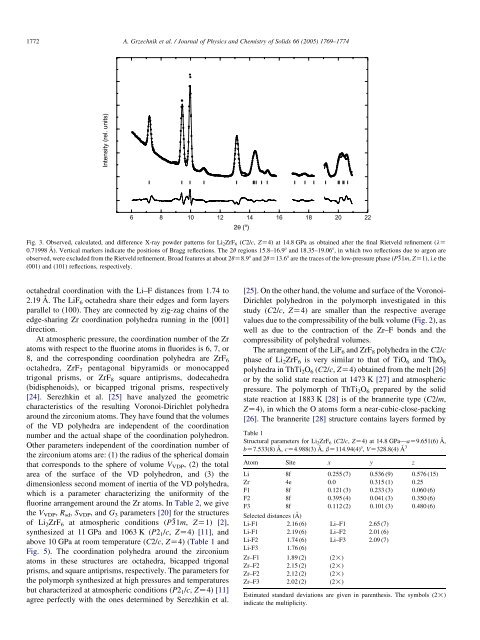Dilithium zirconium hexafluoride Li2ZrF6 at high ... - ResearchGate
Dilithium zirconium hexafluoride Li2ZrF6 at high ... - ResearchGate
Dilithium zirconium hexafluoride Li2ZrF6 at high ... - ResearchGate
You also want an ePaper? Increase the reach of your titles
YUMPU automatically turns print PDFs into web optimized ePapers that Google loves.
1772<br />
Intensity (rel. units)<br />
A. Grzechnik et al. / Journal of Physics and Chemistry of Solids 66 (2005) 1769–1774<br />
octahedral coordin<strong>at</strong>ion with the Li–F distances from 1.74 to<br />
2.19 A˚ . The LiF 6 octahedra share their edges and form layers<br />
parallel to (100). They are connected by zig-zag chains of the<br />
edge-sharing Zr coordin<strong>at</strong>ion polyhedra running in the [001]<br />
direction.<br />
At <strong>at</strong>mospheric pressure, the coordin<strong>at</strong>ion number of the Zr<br />
<strong>at</strong>oms with respect to the fluorine <strong>at</strong>oms in fluorides is 6, 7, or<br />
8, and the corresponding coordin<strong>at</strong>ion polyhedra are ZrF6<br />
octahedra, ZrF 7 pentagonal bipyramids or monocapped<br />
trigonal prisms, or ZrF8 square antiprisms, dodecahedra<br />
(bidisphenoids), or bicapped trigonal prisms, respectively<br />
[24]. Serezhkin et al. [25] have analyzed the geometric<br />
characteristics of the resulting Voronoi-Dirichlet polyhedra<br />
around the <strong>zirconium</strong> <strong>at</strong>oms. They have found th<strong>at</strong> the volumes<br />
of the VD polyhedra are independent of the coordin<strong>at</strong>ion<br />
number and the actual shape of the coordin<strong>at</strong>ion polyhedron.<br />
Other parameters independent of the coordin<strong>at</strong>ion number of<br />
the <strong>zirconium</strong> <strong>at</strong>oms are: (1) the radius of the spherical domain<br />
th<strong>at</strong> corresponds to the sphere of volume VVDP, (2) the total<br />
area of the surface of the VD polyhedron, and (3) the<br />
dimensionless second moment of inertia of the VD polyhedra,<br />
which is a parameter characterizing the uniformity of the<br />
fluorine arrangement around the Zr <strong>at</strong>oms. In Table 2, we give<br />
the V VDP, R sd, S VDP, and G 3 parameters [20] for the structures<br />
of <strong>Li2ZrF6</strong> <strong>at</strong> <strong>at</strong>mospheric conditions (P31m, ZZ1) [2],<br />
synthesized <strong>at</strong> 11 GPa and 1063 K (P21/c, ZZ4) [11], and<br />
above 10 GPa <strong>at</strong> room temper<strong>at</strong>ure (C2/c, ZZ4) (Table 1 and<br />
Fig. 5). The coordin<strong>at</strong>ion polyhedra around the <strong>zirconium</strong><br />
<strong>at</strong>oms in these structures are octahedra, bicapped trigonal<br />
prisms, and square antiprisms, respectively. The parameters for<br />
the polymorph synthesized <strong>at</strong> <strong>high</strong> pressures and temper<strong>at</strong>ures<br />
but characterized <strong>at</strong> <strong>at</strong>mospheric conditions (P21/c, ZZ4) [11]<br />
agree perfectly with the ones determined by Serezhkin et al.<br />
6 8 10 12 14 16 18 20 22<br />
Fig. 3. Observed, calcul<strong>at</strong>ed, and difference X-ray powder p<strong>at</strong>terns for <strong>Li2ZrF6</strong> (C2/c, ZZ4) <strong>at</strong> 14.8 GPa as obtained after the final Rietveld refinement (lZ<br />
0.71998 A˚ ). Vertical markers indic<strong>at</strong>e the positions of Bragg reflections. The 2q regions 15.8–16.98 and 18.35–19.068, in which two reflections due to argon are<br />
observed, were excluded from the Rietveld refinement. Broad fe<strong>at</strong>ures <strong>at</strong> about 2qZ8.98 and 2qZ13.68 are the traces of the low-pressure phase (P31m, ZZ1), i.e the<br />
(001) and (101) reflections, respectively.<br />
[25]. On the other hand, the volume and surface of the Voronoi-<br />
Dirichlet polyhedron in the polymorph investig<strong>at</strong>ed in this<br />
study (C2/c, ZZ4) are smaller than the respective average<br />
values due to the compressibility of the bulk volume (Fig. 2), as<br />
well as due to the contraction of the Zr–F bonds and the<br />
compressibility of polyhedral volumes.<br />
The arrangement of the LiF6 and ZrF8 polyhedra in the C2/c<br />
phase of Li 2ZrF 6 is very similar to th<strong>at</strong> of TiO 6 and ThO 8<br />
polyhedra in ThTi2O6 (C2/c, ZZ4) obtained from the melt [26]<br />
or by the solid st<strong>at</strong>e reaction <strong>at</strong> 1473 K [27] and <strong>at</strong>mospheric<br />
pressure. The polymorph of ThTi2O6 prepared by the solid<br />
st<strong>at</strong>e reaction <strong>at</strong> 1883 K [28] is of the brannerite type (C2/m,<br />
ZZ4), in which the O <strong>at</strong>oms form a near-cubic-close-packing<br />
[26]. The brannerite [28] structure contains layers formed by<br />
Table 1<br />
Structural parameters for Li 2ZrF 6 (C2/c, ZZ4) <strong>at</strong> 14.8 GPa—aZ9.651(6) A˚ ,<br />
bZ7.533(8) A˚ , cZ4.988(3) A˚ , bZ114.94(4)8, VZ328.8(4) A˚ 3<br />
Atom Site x y z<br />
Li 8f 0.255 (7) 0.536 (9) 0.576 (15)<br />
Zr 4e 0.0 0.315 (1) 0.25<br />
F1 8f 0.121 (3) 0.233 (3) 0.060 (6)<br />
F2 8f 0.395 (4) 0.041 (3) 0.350 (6)<br />
F3 8f 0.112 (2) 0.101 (3) 0.480 (6)<br />
Selected distances (A˚ )<br />
Li-F1 2.16 (6) Li–F1 2.65 (7)<br />
Li-F1 2.19 (6) Li–F2 2.01 (6)<br />
Li-F2 1.74 (6) Li–F3 2.09 (7)<br />
Li-F3 1.76 (6)<br />
Zr–F1 1.89 (2) (2!)<br />
Zr–F2 2.15 (2) (2!)<br />
Zr–F2 2.12 (2) (2!)<br />
Zr–F3 2.02 (2) (2!)<br />
Estim<strong>at</strong>ed standard devi<strong>at</strong>ions are given in parenthesis. The symbols (2!)<br />
indic<strong>at</strong>e the multiplicity.




